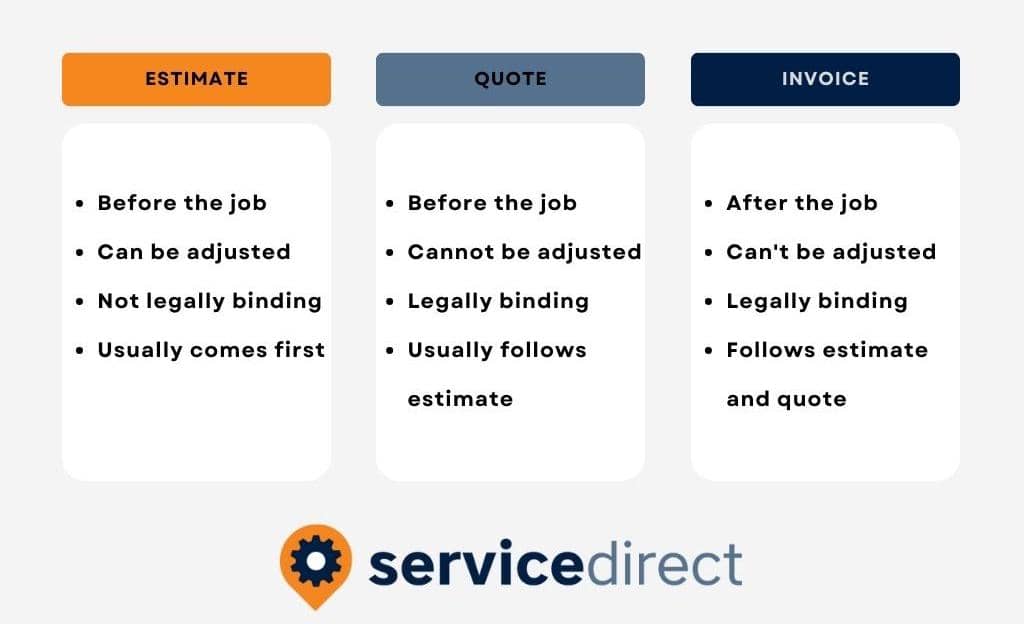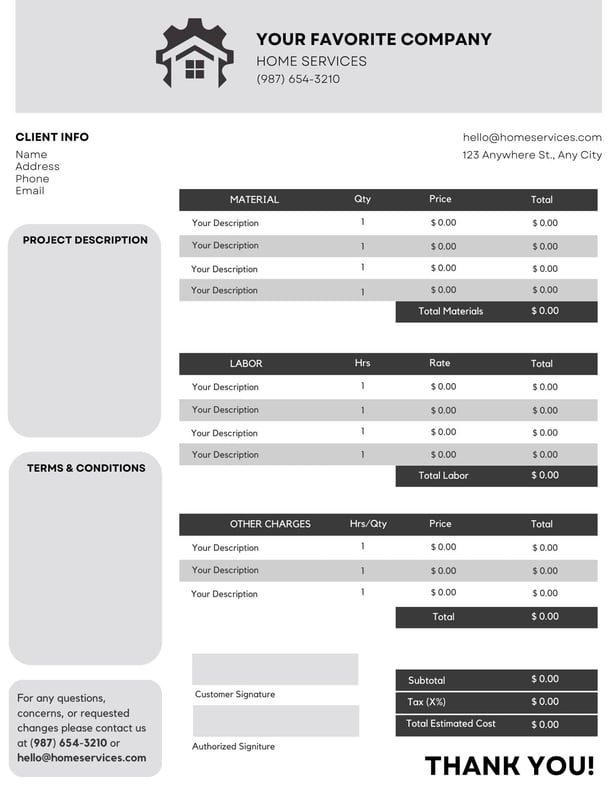How to Write an Estimate for a Job
If you are running a small business, then you already know that there is no shortage of boxes to check and strategies to implement. Whether you want to work on affordable marketing solutions to connect with new people, invest in lead generation services to increase your customer base, or finally iron out the perfect budget, you’ve got a lot to think about.
But before you invest too much time into implementing new strategies, you first need to perfect what you already have, which includes learning how to write a professional estimate for a job. Your jobs are what keep your company afloat, after all, and you want to make sure both you and the customer are on the same page.
You most likely already know that job estimates are essential for clients and service providers alike as they set expectations, establish clear communication, and ensure transparency in costs.
With a well-written job estimate, you can help win clients, build trust, and contribute to business growth. On the other hand, providing a poor estimate or not using an estimate at all can lead to frustrations, lost business, and even disputes down the road.
In this article we will explain what a job estimate is, the key steps to creating an accurate estimate, and how to follow through to ensure maximum customer satisfaction.
What is a Job Estimate?
A job estimate is an approximate calculation of the cost involved in completing a specific project or providing a service. Its purpose is to give your client an idea of the expenses they can expect before committing to the project.
In short, an estimate helps set realistic expectations and serves as a starting point for further discussions and negotiations between the client and the business.
How Job Estimates Differ From Invoices and Quotes
Job estimates differ from quotes and invoices in their level of detail, commitment, and timeline.

A job estimate serves as a preliminary assessment of costs, outlining the key aspects of the project and providing a ballpark figure. It helps both the service provider and the client to understand the scope and potential financial implications of the work.
It's important to communicate to clients that an estimate is subject to revision as more information becomes available or unforeseen circumstances arise during the project. This transparency helps manage expectations and avoids any misunderstandings later on.
Step 1: Gathering Information
To begin writing a job estimate, you need to gather information so that you can provide an estimate that is as close to the actual cost of the job as possible.
First, it's crucial to have a clear understanding of the client's specific requirements. That means determining their project expectations, desired outcomes, and any special considerations. Ask relevant questions to ensure you have a comprehensive understanding of the scope of work.
Next, you want to visit the project site, if applicable. Site visits allow you to understand the environment, identify specific requirements, and assess any potential challenges.
This on-site assessment helps in providing a more precise estimate by considering factors that may affect the cost or duration of the project and can be especially useful for home service businesses like electricians, roofers, and painters.
Finally, taking accurate measurements is essential for generating a reliable estimate. Depending on the nature of the project, ensure that you take precise measurements of areas, dimensions, or quantities of materials required.
Step 2: Calculating Costs
Now that you have an understanding of the job details, you’ll need to do some math to calculate how much the job is likely to cost you.

Keep these steps in mind when calculating costs for a job estimate:
- Determine the labor costs by estimating the time required for each task and the number of employees needed to complete them. Research industry-standard labor rates if you’re stuck on this.
- Calculate material costs by researching current market prices or contacting suppliers. Consider the quantity and quality of materials needed, and try to account for any potential fluctuations in prices.
- Consider any other expenses that may be associated with the project such as equipment rentals, transportation, or disposal fees. Take into account any overhead costs specific to your business, such as administrative expenses or insurance.
- Include contingencies in your cost estimation. Unexpected situations or changes in project requirements may arise, so it's wise to allocate a portion of the estimate as a contingency fund. This provides a buffer to handle unforeseen expenses without disrupting the project's progress or exceeding the budget.
Step 3: Creating a Clear Estimate
With all of your information collected, it’s time to begin drafting a clear and comprehensive document that clients can easily understand and reference. You’ll need to include as many details as possible to foster transparency, build trust, and facilitate smoother project negotiations and agreements.
Follow these steps to create your job estimate:
- Structure your estimate document in a clear and organized manner to enhance readability and understanding
- Clearly outline the scope of work without using complex terminology that may confuse the client. Focus on communicating the value and benefits the client will receive from your services.
- Break down the estimate by individual components, providing a clear list of costs associated with labor, materials, and more.
- If there are any additional charges or fees beyond the core project costs, clearly outline them in the estimate. This could include taxes, service fees, or any specific expenses directly related to the project.
- Clearly state the terms and conditions of the estimate, including the validity period, payment terms, and any specific contractual obligations.
By following the above steps, you’ll be able to create a job estimate that clearly communicates expectations and sets everyone involved up for success. And just remember—transparency is your best friend when drafting a job estimate.

Step 4: Presenting the Job Estimate
It’s always important to remember that you are working with someone who may not have much industry knowledge. You want to provide an estimate that is professional while also being easy to understand.
You can do this by creating the estimate in a professional, readable format that includes clear headings and bullet points. Additionally, you’ll want to avoid business jargon, be courteous, and maintain a warm tone all to foster a sense of collaboration between your business and the client.
It’s also crucial to remember that an estimate is not written in stone from the moment you present it to the client. Conclude the estimate by encouraging clients to ask questions or seek clarification.
Provide your contact information and invite them to reach out for any further information or to discuss the estimate in detail. This shows your willingness to engage in open communication and ensures that clients feel comfortable addressing any concerns or queries they may have.
Step 5: Reviewing and Refining the Estimate
Before finalizing the estimate, it's crucial to review and refine it for accuracy and completeness. Review the estimate to ensure that all necessary information is included as well as any doable changes that the client requested.
By conducting a thorough review process, you can enhance the credibility of the job estimate and minimize the likelihood of errors or misunderstandings, ultimately increasing the chances of project success.
Conclusion
Now that you have a completed estimate you can send it to the client! Choose the appropriate format—email, print, digital document—and set a reasonable expiration date that the client needs to respond by. Don’t forget to follow up a few days before the expiration date if you haven’t heard back.
By following the steps laid out in this blog, you should be able to write a professional job estimate that will impress your clients and set your small business up for success. And remember, a well-crafted job estimate showcases your professionalism and expertise, ultimately contributing to the growth and success of your business.



